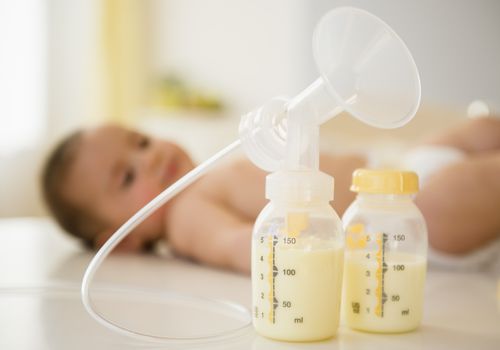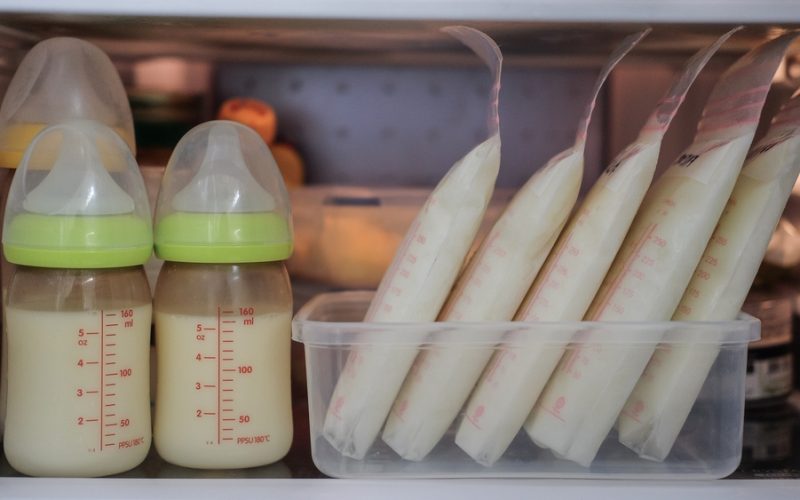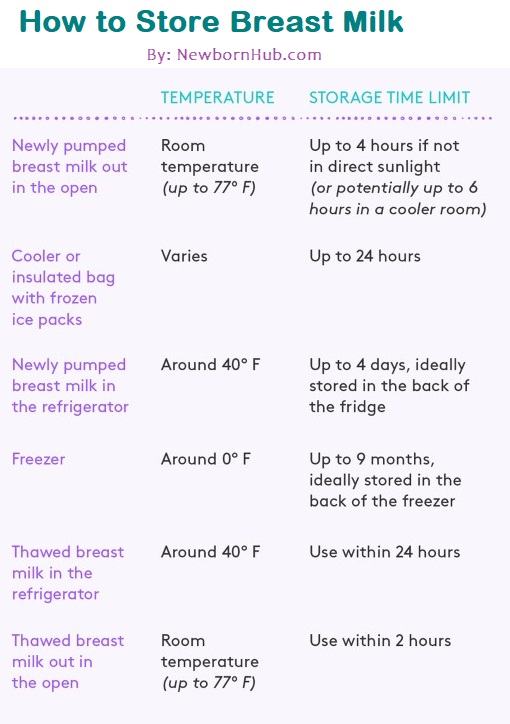- HOME
- Breastfeeding
- Breastfeeding and Pumping
Breastfeeding and Pumping
Here we have everything you need to know about breastfeeding and pumping. Ever tried feeding your baby breast milk from a bottle? It's like all the goodness of the world stored in a little bottle - with an extra touch of convenience. And how wonderful is that!
In this section:
- Types of breast pumps
- Benefits of pumping your breasts
- How to pump breastmilk?
- Pumping and breastfeeding schedule
- Storing breast milk in fridge
- How to freeze breast milk?
- How to thaw breast milk?
- When not to breastfeed and pump?
If we were kangaroos, we would put our newborn babies in our pouch and jump around all day long, finishing up our chores while caring for and feeding our baby at the same time. But, we are not.
Luckily, we have a great option that could help us in providing healthy breast milk to our young ones, without binding us to breastfeed for long intervals and making life quite closer to the pre-baby work routine (almost!). This option is called Breastfeeding and Pumping.
Types of Breast pumps
Whoever gave the idea of using breastfeeding pumps, was certainly a noble person who knew the real importance of breastmilk. For expressing your milk, you need a breast pump that suits you. There are two main types of breast pumps:
- Manual breast pumps
- Electric breast pumps
If you are just experimenting with the breastfeeding and pumping process, we would recommend you to use a manual breastpump (they don't cost much as compared to the electric ones). You need to first check whether using a breastfeeding pump and storing breastmilk is feasible for you or not. Once you realize you need it and find breastfeeding and pumping convenient for later use, you could look out at the electric breast pumps available in the market.
If at any point you feel that your milk flow is not adequate, make sure you read our article on 8 effective ways to improve the flow and quality of your breastmilk. But remember that regular pumping is a proven way to increase breast milk, because when you empty one breast completely, more milk is produced to meet the milk demand (ever heard of the Demand-Supply ratio?)
Benefits of Pumping
There are multiple reasons why you would want to pump your breast milk. From collecting milk so your baby can have it when you resume work to leaving a bottle full of breast milk for the baby’s nanny or caregiver when you want a night out; increasing breast milk supply to relieving engorgements. Breastfeeding and pumping go hand in hand. When you pump your breast milk, your baby continues to get the benefits of breast milk even when the baby is away from you.
In some cases, mothers want to breastfeed their babies but cannot nurse due to certain reasons (including poor latch, low or slow milk supply, etc.) can pump their breast milk and feed it through a bottle. Viola!
Whatever reason you have to go for a breastfeeding and pumping routine, here are some of the many benefits pumping offers:
- Just because you’re the one with breasts does not mean you have to take the feeding responsibility all the time (you deserve some “me-time” too). When you pump and store the milk, your partner or your baby’s caregiver can take the responsibility of feeding your baby without compromising on the goodness of breast milk.
- You can resume work after your maternity leave is over without worrying about breastfeeding your baby.
- You can run errands, enjoy a day out, a night-out, go to cinema with your friends, take a vacation, or travel for business reasons.
- You can increase your milk supply by regular pumping. This way your baby can have enough milk until he/ she is full, and you can still manage to pump and store for later use.
- Pumping gives you the chance to donate your extra milk to mothers who cannot breastfeed their babies. This way you are not just giving your baby the benefits of breast milk, you are passing on the goodness to other babies and helping stressed moms out there. This will also make you feel good about yourself.
How to pump breast milk?
Before starting to use a breast pump, gently massage your breasts with your hands. If you are using electric breast pumps, pump for 15 minutes, then take some break by softly massaging your breast and then pump for 10 more minutes. Repeat this for the second breast.
If you are manually expressing your breastmilk using a breastfeeding pump, your breast generally gets massaged when you try to pump it. Still it is a good idea to gently massage before and between the pumping process.
Here is how you start pumping:
- Wash your hands with soap and warm water before starting pumping. Make sure the pump is also clean.
- Hydrate yourself. Drink water or a glass of juice or milk to make sure your body is hydrated.
- Find a quiet and comfy spot. Sit at a relaxing place that is quiet and comfortable. You can take some deep breaths or try a couple of minutes of meditation to calm your body down.
- Assemble the pump kit. Plug in your pump or make sure it has batteries.
- Massage your breasts. Studies have suggested that a warm compress or a gentle breast massage helps you with the letdown process.
- Visualize your baby. If your baby is close by, you can pick your baby up for a cuddle. This signals your body to start the letdown process. Make sure you do not hold your baby for a long time as it may result in your baby wanting attention or even the milk that you plan to pump out.
If you are at work, you can find a private area away from distractions and look at your baby’s picture or watch a video or listen to the sound clip of your baby. This will signal your brain that the baby is close by and that the body needs to produce milk. - Ensure a good seal. You can moisten the lip of the suction cup (flange) with water to make sure you have a good seal of the suction cup.
- Center the nipple. Before starting, make sure your nipple is in the middle of the flange.
- Turn on the pump. Most electric breast pumps start with a letdown phase. In this phase the suction is just like that of the initial suckling of your baby – shorter and faster. This helps in the letdown process. After a few minutes, the suction starts to pace up and the pump switches to its regular mode.
- Do not start with the highest suction level. Always start with the default or low suction level. You can gradually increase it to high (or many pumps automatically do that). Make sure the suction and pumping does not hurt. If it hurts, it means your suction is too high, so reduce it. Remember, high suction does not necessarily mean more milk. You need to start slowly and then the milk flow will eventually increase.
Pumping and Breastfeeding Schedule
In order to create a pumping and breastfeeding schedule, you need to consider a couple of things. If your baby is full-term, healthy, and happily breastfeeding, you can wait for a week or so before your start pumping and storing your breast milk.
In case you have a premature (preterm) baby, your baby is un-well, cannot latch on properly, or if you have decided to exclusively pump, you must start pumping right after birth (ideally within 1 to 6 hours of your delivery).
If you are primarily breastfeeding:
You do not want to pump out all the milk and store it for future and leave your baby hungry. To make a breastfeeding and pumping routine if you are primarily breastfeeding (meaning your baby breastfeeds and you want to store the milk for later or future usage), do the following:
- Many moms have the best milk supply first thing in the morning. So, pump in the morning.
- Once you have breastfed your baby, wait for 30 to 60 minutes for your breasts to produce more milk, and then pump. You can also pump at least one hour before breastfeeding. This way, your baby can have lots of milk at their feeding time.
- In case you have just finished your pumping and your baby wants to breastfeed straightaway, do not wait for them to cry their lungs out. Let them nurse. Some babies just want to suck and feel their mother around them. However, they will be feeding longer than their average feed time to get the desired amount of milk (since your body will be low in breast milk due to pumping), but they will eventually get the milk.
If you are exclusively pumping:
In case you are exclusively breast pumping, which means, you are not breastfeeding at all and only feeding your breast milk via bottle, here is what your pumping schedule needs to be:
- Pump anywhere from 8 to 10 times a day (in 24 hours). You will notice that in a 24-hour period, the full milk production is around 25 oz to 35 oz (750 ml to 1,035 ml).
- You may not reach the full milk production on the first few days but when you do, maintain this level of 25 oz – 35 oz milk production each day. Make a pumping schedule that suits you better (like before going to work, during the work-break, every 2 – 3 hours if you are at home.
- Your pumping schedule does not have to be exactly like another pumping mom as long as your baby is full, happy, and healthy. Plan your pumping sessions according to your daily activities and whatever works best for the two of you. If you are exclusively pumping, it is crucial for you to have an excellent quality breast pump.
How to Store your Breast Milk:
It is natural for your breast milk to separate in multiple layers (a milk layer and a cream layer at the top) when it is stored. Although it's consistency may look different than a formula milk, it is perfectly fine to consume. Just make sure you swirl it before feeding your baby. If however, you swirl it and the milk still has lumps in it, throw the milk away. It means the milk has gone bad.
Whichever pumping technique you use, make sure you take extra care to keep the expressed breast-milk in a safe and clean place. If you want to store it for future use, make sure you remember these storage guidelines.
Some doctors recommend the "5-7 rule" that help you remember the storing time. You can safely keep the expressed breastmilk for:
- 5 – 7 hours at room temperature when the breastmilk is freshly expressed.
- 5 – 7 days in the fridge.
- 5 – 7 months in the freezer (According to the new guidelines, if the milk is carefully frozen, you can keep it up to 12 months in the freezer)
But this has changed a bit and also needs some clarification. The storage time in the fridge for freshly pumped breast milk cannot really be the same as the thawed (previously frozen) milk, can it? What if you have some left-over breast milk in your baby's feeding bottle - it won't be as fresh as an untouched batch of breast milk. Here's to make life easy for you:
- If you have freshly pumped out the breast milk, you can store it at the back of the refrigerator for up to 4 days. The ideal temperature will be around 4 degrees Celsius or 39 degrees Fahrenheit. Just make sure you don’t forget its at the back of the refrigerator – do not put big object in front of it that could hide the milk. You can make a section in your fridge that is exclusively for your milk storage. This way, you know where to look for when looking for the stored milk.
- In case of thawed milk that has been previously frozen, make sure your baby consumes it within a day (24 hours), otherwise you will have to discard it (ouch! No one likes to throw their precious liquid gold). A good tip is to only thaw the amount of milk you know your baby will consume (you can always thaw more if your baby is still hungry). Do not refreeze breast milk once it has been thawed.
- If your baby did not finish up the entire thawed milk and you have got some left-over milk in the feeding bottle, give it to your baby again within 2 hours. After that, you must discard it (I know it hurts to!).
Before starting the storing process, make sure that the container you use is sterilized and your hands and breasts are clean. You can store and thaw in your baby's sterilized milk bottle or milk storage bags. To know more about effective bottle sterilization processes, click here.
How to freeze your Breast Milk?
If you want to freeze your breastmilk, make sure that the freezer temperature you are setting results in making the frozen breastmilk rock solid. A good idea to judge if the freezer has the right freezing temperature is to check the ice cream present in it. If the ice cream is hard, this indicates that the mothers milk will also be frozen properly. If it is slightly on the soft side, increase the coolness of the freezer.
How long does the milk last in the freezer depends upon the type of freezer you are using. As per the American Academy of Pediatrics, if you are storing the breast milk in a freezer which is part of a refrigerator (with separate doors), you can freeze the breast milk (-18°C or 0°F) for as long as 9 months. If the freezer you are using is a deep freezer (chest), you can freeze it for as long as 12 months as the temperature is much cold (-20°C or -4°F). Just like in case of the fridge, make sure you store the milk at the back of the freezer where the temperature does not fluctuate when you open/close your freezer and is always around 0°F. It is recommended that you use the frozen breast milk earlier than the 9 – 12 months’ time as longer storage reduces the amount of Vitamin C.
When freezing the milk, store in smaller portions like 2 to 4 ounces (59.1 to 118.2 mm) so you don’t end up wasting any thawed milk. You can always thaw more milk if your baby needs more.
Don’t forget to label the storage bags or bottles with the date your pumped the milk. This will help you use the milk in a more organized way.
Leave some space at the top of the storage bag/ bottle as breast milk expands as it freezes.
How to Thaw Breast Milk?
The safest way to thaw your breast milk (from frozen state) is to shift the milk from the freezer to the fridge and let it sit there overnight. You can also fill a bowl with warm water and let the frozen milk bottle or bag stay in it to slowly thaw.
Never microwave the frozen milk as its radio waves can destroy some of the important nutrients found in breast milk. Furthermore, radio waves can make the milk too hot that might burn your baby’s mouth.
Do not boil the breast milk or put it on stove to thaw. This will not only make the milk lose its precious nutritive properties, it could end up being too hot for the baby.
Once you have thawed the breast milk, make sure your baby fishes it up the same day. Put the leftover thawed milk in the fridge and use it within 24 hours.
The thawed breast milk may or may not smell a little different from the fresh breast milk due to an enzyme known as lipase. If your baby is not too keen on drinking the thawed milk, hold your baby close to your skin when feeding him/her. You can also talk to your doctor to discuss ways to neutralize this enzyme so the milk does not smell funny to your baby.
The reward for all your breastfeeding and pumping is when you thaw the frozen milk. It's like you can get the milk anytime you want to give it to your baby.
When not to go for breastfeeding and pumping:
There are however rare instances when a mother's milk is not advisable for her baby. Make sure you read our article on when not to breastfeed.
To Sum up Breastfeeding and Pumping...
Breastfeeding and pumping is not as scary as it seems, right? You'll soon get used to a breastfeeding and pumping routine. Remember that breast milk is the most amazing gift a mother can give to her baby. Even if you have a busy schedule that cannot allow you to sit and breastfeed your newborn, you could always store this incredible milk at a convenient time, and your partner, nanny or caregiver could give it to your baby.
Pumping is half the story. The other half is storing the milk. You can store the milk at room temperature, in the fridge, and in the freezer for future use. How long does the breast milk last in the fridge depends upon the type of the milk – whether it is freshly pumped, thawed (from previously frozen state), or is a left-over from your baby’s previous feeding. To thaw the frozen milk, take it out of the freezer and run the bottle or container under a warm tap water or dip the container carefully in warm water.
If at any stage you feel like giving up breastfeeding and shifting to the formula, make sure you read our article on breastfeed vs formula feed. You can always refer to our formula feeding section in case you decide to opt for formula milk.
But don't be put off by the little extra work that breastfeeding and pumping (and storing) involves. Your baby is worth it. Totally!
Return to Breastfeeding section.
Return to Homepage.
See Also:
- How to breastfeed a newborn?
- Breastfeed vs bottle feed
- Breastfeeding and pumping
- Breastfeeding problems and their solutions
- How long should women breastfeed for?
- Breastfeeding tips
- How to increase breast milk?
- When should you not breastfeed?
- Why should you breastfeed?
- Foods to eat & foods to avoid when breastfeeding
- What accessories do I need when breastfeeding?
- Breastfeeding advantages for mothers







New! Comments
Have something to say about what you just read? Leave me a comment in the box below :)